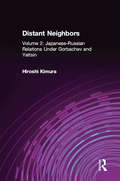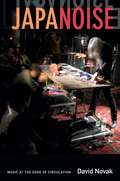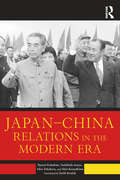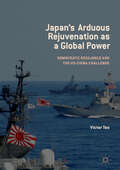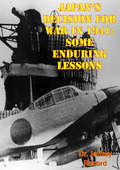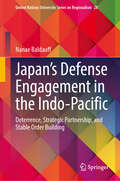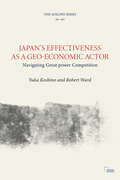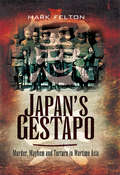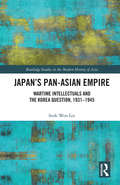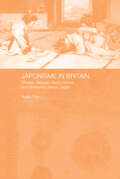- Table View
- List View
Japanese-Russian Relations Under Gorbachev and Yeltsin
by Hiroshi KimuraWhy has the stalemate in Japanese-Russian relations persisted through the end of the Cold War and Moscow's weakening control over its far eastern territories? In this volume Kimura continues his comprehensive analysis of Russia and Japan's strained and unstable relations to the present day.
Japanoise: Music at the Edge of Circulation
by David NovakNoise, an underground music made through an amalgam of feedback, distortion, and electronic effects, first emerged as a genre in the 1980s, circulating on cassette tapes traded between fans in Japan, Europe, and North America. With its cultivated obscurity, ear-shattering sound, and over-the-top performances, Noise has captured the imagination of a small but passionate transnational audience. For its scattered listeners, Noise always seems to be new and to come from somewhere else: in North America, it was called "Japanoise. " But does Noise really belong to Japan? Is it even music at all? And why has Noise become such a compelling metaphor for the complexities of globalization and participatory media at the turn of the millennium? In Japanoise, David Novak draws on more than a decade of research in Japan and the United States to trace the "cultural feedback" that generates and sustains Noise. He provides a rich ethnographic account of live performances, the circulation of recordings, and the lives and creative practices of musicians and listeners. He explores the technologies of Noise and the productive distortions of its networks. Capturing the textures of feedback--its sonic and cultural layers and vibrations--Novak describes musical circulation through sound and listening, recording and performance, international exchange, and the social interpretations of media.
Japans Blitzkrieg: The Allied Collapse in the East, 1941–42
by Bernard EdwardsEarly on the morning of 7 December 1941, 360 Japanese carrier-borne aircraft made a surprise attack on the US naval base at Pearl Harbor, and laid waste to the American Far East Fleet. They sank four battleships, crippled three cruisers and three destroyers, and seriously damaged two other battleships. One hundred and sixty-four planes were destroyed and 2,403 servicemen and civilians were killed. All for the loss of twenty-nine Japanese aircraft and fifty-five men. Two days later, the British battleships Prince of Wales and Repulse, were sunk by Japanese torpedo bombers as they raced north to intercept an enemy invasion force heading for Malaya. In these two bold forays, the Japanese had successfully emasculated Allied naval power in the East. There now remained no big guns afloat anywhere in the Pacific and Indian oceans capable of opposing Admiral Yamamoto's ships.So began Japan's blitzkrieg. The Malay peninsular was rapidly overwhelmed, Hong Kong surrendered on Christmas Day, Manila went the same way on the 31st, and on 15 February 1942, in one of the most ignominious defeats in modern warfare, 85,000 British troops laid down their arms, and the vital base of Singapore was in Japanese hands. Thereafter, the rays of the Rising Sun spread ever outwards, overrunning island after island, until even Australia was threatened. The book tells how the Dutch Spice Islands, Java and Sumatra, became a last refuge for those fleeing before the Japanese whirlwind advance, and it was from here that the remaining Allied merchant ships in the area made their bid for freedom carrying hundreds of refugees. For many of these ships it was to be their last voyage
Japan–China Relations in the Modern Era
by Yoshihide Soeya Akio Takahara Ryosei Kokubun Shin KawashimaFrom before the dawn of recorded history, there has been a rich flow of interaction between Japan and China. Japan has long learned many things from Chinese civilization, and since the modern era China began to learn from Japan. In the twenty-first century, however, China surpassed Japan in terms of GDP in 2010 to become the world’s second largest economy. Amid this rapid rise of China and what has been called a power-shift in Japan–China relations, there are signs that bilateral tensions are rising and that the image each country has of the other is worsening. This volume provides a cogent analysis of the politics of the bilateral relationship in the modern era, explaining the past, present, and future of Japan–China relations during a time of massive political, social, and economic changes. Written by a team of internationally renowned Japanese scholars and based on sources not available in English, this book is essential reading for students and scholars of Japan–China relations, Japanese international relations, and the politics and international relations of East Asia
Japan’s American Interlude
by Prof. Kazuo KawaiHow did the Japanese themselves respond to the American occupation? How were the sweeping reforms—political, social, and economic—of SCAP’s program received? How permanent was their effect, and why did some succeed and others fail completely? How successful in the long view was the democratization induced by MacArthur’s “artificial revolution”? And what tendencies existing in fundamental Japanese attitudes and history might account for this peculiar success?Kazuo Kawai, Japanese-born and educated in America, a political scientist and journalist, brings his unique experience and knowledge to bear on these questions. The result is a book which tells the story of the American occupation of Japan from the Japanese point of view.“This book deals with the American interlude in the history of Japan during which time that country was not only occupied by American troops and politically controlled by American officials but was subjected to almost every conceivable variety of American influence. It does not attempt to tell the story of the Occupation itself, for that story has already been told many times by Americans who, as participants or close observers, were in a position to tell it well. Instead, this work deals only with selected controversial aspects of the Japanese reaction to American influence during the Occupation period.”—Kazuo Kawai, Preface
Japan’s Arduous Rejuvenation as a Global Power: Democratic Resilience and the US-China Challenge
by Victor TeoThis open access book assesses the profound impact of Japan’s aspirations to become a great power on Japanese security, democracy and foreign relations. Rather than viewing the process of normalization and rejuvenation as two decades of remilitarization in face of rapidly changing strategic environment and domestic political circumstances, this volume contextualizes Japan’s contemporary international relations against the longer grain of Japanese historical interactions. It demonstrates that policies and statecraft in the Prime Minister Shinzo Abe’s era are a continuation of a long, unbroken and arduous effort by successive generations of leaders to preserve Japanese autonomy, enhance security and advance Japanese national interests. Arguing against the notion that Japan cannot work with China as long as the US-Japan alliance is in place, the book suggests that Tokyo could forge constructive relations with Beijing by engaging China in joint projects in and outside of the Asia-Pacific in issue areas such as infrastructure development or in the provision of international public goods. It also submits that an improvement in Japan-China relations would enhance rather than detract Japan-US relations and that Tokyo will find that her new found autonomy in the US-Japan alliance would not only accord her more political respect and strategic latitude, but also allow her to ameliorate the excesses of American foreign policy adventurism, paving for her to become a truly normal great power.
Japan’s Asian Diplomacy: Power Transition, Domestic Politics, and Diffusion of Ideas (Critical Studies of the Asia-Pacific)
by Hidetaka YoshimatsuThis book provides a comprehensive analysis of Japan’s Asian diplomacy under Prime Minister Shinzō Abe. Under the Kantei-centred policymaking system, Shinzō Abe has implemented assertive foreign policies with a slogan of ‘diplomacy taking a panoramic perspective of the world’. The analyses in the book cover the traditional and emerging fields of national security and international political economy. While its empirical examination is based on field-specific research, it also incorporates the analysis of Japan’s bilateral relations with China, the US, India, and others. In addition, the book provides a solid, theory-driven analysis of Japan’s external policy and relations. In an independent chapter, this work sets up integrative theoretical frameworks for empirical analyses by relying on key concepts drawn from the three international relations theories of realism, liberalism and constructivism. Going forward, research in this book also explores the development of key regional affairs. Maritime security and space security are two of major security-related affairs, in which the states in East Asia and the Asia-Pacific have to engage, including the development of the TPP (TPP-11) and RCEP, as well as infrastructure development and development cooperation, which are crucial in relation to China’s initiatives in the BRI and AIIB. Lastly, the book provides valuable references to regionalism in East Asia and the Asia-Pacific by analyzing regional integration/cooperation through free trade agreements and the development of regional connectivity. This includes the evolution of cooperation and conflict within key regional frameworks such as the East Asia Summit and APEC, as well as key regional visions such as the Free and Open Indo-Pacific. It also takes into account the possible influence of ideational factors such as norms, principles, and rules on the development of regional cooperation.
Japan’s Decision For War In 1941: Some Enduring Lessons - War College Series
by Dr Jeffrey RecordJapan's decision to attack the United States in 1941 is widely regarded as irrational to the point of suicidal. How could Japan hope to survive a war with, much less defeat, an enemy possessing an invulnerable homeland and an industrial base 10 times that of Japan? The Pacific War was one that Japan was always going to lose, so how does one explain Tokyo's decision? Did the Japanese recognize the odds against them? Did they have a concept of victory, or at least of avoiding defeat? Or did the Japanese prefer a lost war to an unacceptable peace?Dr. Jeffrey Record takes a fresh look at Japan's decision for war, and concludes that it was dictated by Japanese pride and the threatened economic destruction of Japan by the United States. He believes that Japanese aggression in East Asia was the root cause of the Pacific War, but argues that the road to war in 1941 was built on American as well as Japanese miscalculations and that both sides suffered from cultural ignorance and racial arrogance. Record finds that the Americans underestimated the role of fear and honor in Japanese calculations and overestimated the effectiveness of economic sanctions as a deterrent to war, whereas the Japanese underestimated the cohesion and resolve of an aroused American society and overestimated their own martial prowess as a means of defeating U.S. material superiority. He believes that the failure of deterrence was mutual, and that the descent of the United States and Japan into war contains lessons of great and continuing relevance to American foreign policy and defense decision-makers.
Japan’s Defense Engagement in the Indo-Pacific: Deterrence, Strategic Partnership, and Stable Order Building (United Nations University Series on Regionalism #28)
by Nanae BaldauffThis original book systematically examines Japan’s defense engagement with its strategic partners since the end of the Cold War based on Japan’s national security strategy. The author maps three defense engagement activities: military exercises, capacity building, and defense equipment transfer and technology cooperation – and subsequently evaluates these against the three national security objectives: deterrence, cooperative security, and the Free and Open Indo-Pacific vision. The book asks two important research questions: why is Japan active in defense engagement with the armed forces of its strategic partners? And, what purposes do Japan’s self-defense forces pursue? Through the ten carefully selected cases of strategic partners: Australia, India, Indonesia, Vietnam, the Philippines, ASEAN, the UK, France, NATO, and the EU, the book follows a structured, cross-case comparison based on the analytical framework developed for the research. It also discusses the evolution of Japan’s postwar defense policy, providing a solid background for the case studies. The book overall argues that, while the Japan-US alliance is still the most indispensable, Japan’s strategic partnerships are a valuable instrument of deterrence that contributes to Japan’s national security objectives. In order to more effectively pursue these objectives and thus secure the national interest, Japan must pursue a purpose-driven defense engagement.
Japan’s Effectiveness as a Geo-Economic Actor: Navigating Great-Power Competition (Adelphi series)
by Robert Ward Yuka KoshinoGeo-economic strategy – deploying economic instruments to secure foreign-policy aims and to project power – has long been a key element of statecraft. In recent years, it has acquired even greater salience given China’s growing antagonism with the United States and the willingness of both Beijing and Washington to wield economic power in their confrontation. This trend has particular significance for Japan given its often tense political relationship with China, which remains its largest trading partner. While Japan’s post-war geo-economic performance often failed to match its status as one of the world’s largest economies, more recently Tokyo has demonstrated increased geo-economic agency and effectiveness. In this Adelphi book, Yuka Koshino and Robert Ward draw on multiple disciplines – including economics, political economy, foreign policy and security policy – and interviews with key policymakers to examine Japan’s geo-economic power in the context of great-power competition between the US and China. They examine Japan’s previous underperformance, how Tokyo’s understanding of geo-economics has evolved and, given constraints on its national power-projection, what actions Japan might feasibly take to become a more effective geo-economic actor. Their conclusions will be of direct interest not only for all those concerned with Japanese grand strategy and the Asia-Pacific, but also for those middle powers seeking to navigate great-power competition in the coming decades.
Japan’s Financial Slump
by Yasushi SuzukiThis book evaluates the salient features of Japanese relation-based banking, particularly in the post war period, and Anglo-American mode of banking to explain the nature and extent of transition failure that caused prolonged financial and economic slump in Japan.
Japan’s Gestapo: Murder, Mayhem and Torture in Wartime Asia
by Mark FeltonThe book opens by explaining the origins, organisation and roles of the Kempetai apparatus, which exercised virtually unlimited power throughout the Japanese Empire. The author reveals their criminal and collaborationist networks, which extorted huge sums of money from hapless citizens and business. They ran the Allied POW gulag system which treated captives with brutality and a complete lack of mercy.Other Kempetai activities included biological and chemical experiments on live subjects, slave labour, including 'Comfort Women' drawn from all races.Their record of reprisals against military and civilians was unrelenting. For example Colonel Doolittle's raid on Tokyo in 1942 resulted in a campaign of revenge not just against captured airmen but thousands of Chinese civilians. Their actions amounted to genocide on a grand scale.Of particular distaste is the revelation of the Maruta vivisection campaign.The author backs up his text with first hand testimonies from those survivors who suffered at the hands of this evil organization. He examines how the guilty were bought to justice and the resulting claims for compensation.
Japan’s International Cooperation in Education: History and Prospects (Education in the Asia-Pacific Region: Issues, Concerns and Prospects #63)
by Yuto Kitamura Kazuo Kuroda Nobuko KayashimaThis book records the history of Japan’s international cooperation in education from the 1950s to 2020. It provides a crucial overview of the nearly 70 years since Japan began engaging in international cooperation in education in order to record and document these efforts that range from basic to higher education to technical and vocational education and training, and the large numbers of people involved in their respective areas of activity and specialization. The book provides useful indicators for exploring new forms of education cooperation in this age of global governance and beyond. The authors include not only researchers but also field practitioners, such as personnel from the Japan International Cooperation Agency and NGOs.
Japan’s Military Masters: The Army in Japanese Life
by Hillis LoryTHE REALISTIC FACTS ABOUT JAPAN’S CAPACITY—IN MANPOWER AND IN NATIONAL MORALE—TO FIGHT THE “HOLY WAR” HER MILITARY LEADERS HAVE SO LONG PLANNED FOR HERIn Japanese Military Masters: The Army in Japanese Life, author Hillis Lory answers fundamental questions in satisfactory detail. He describes the life and though of the peasant, the motives and personalities of the men close to the Throne. He traces the evolution of Japanese government from feudalism to modern power politics. He records the assassinations, the rebellions, the secret societies, the coups d’état that have shaped it. He recalls the struggle between the liberal and the military leaders for control of Japan’s destiny.“Among the many books about Japan that have appeared since Pearl Harbor, this book is one of the few that could fairly be called indispensable for its high informational content. The author has learned about as much as any foreign could learn about the organization and psychology and training and general make-up of the Japanese Army. And he puts his material together in the style of a good military report, without padding and exaggeration.—The New York Times Book Review
Japan’s Pan-Asian Empire: Wartime Intellectuals and the Korea Question, 1931–1945 (Routledge Studies in the Modern History of Asia)
by Seok-Won LeeThis book is a study of how the theories and actual practices of a Pan-Asian empire were produced during Japan’s war, 1931-1945. As Japan invaded China and conducted a full-scale war against the United States in the late 1930s and early 1940s, several versions of a Pan-Asian empire were presented by Japanese intellectuals, in order to maximize wartime collaboration and mobilization in China and the colonies. A broad group of social scientists – including Rōyama Masamichi, Kada Tetsuji, Ezawa Jōji, Takata Yasuma and Shinmei Masamichi – presented highly politicized visions of a new Asia characterized by a newly shared Asian identity. Critically examining how Japanese social scientists contrived the logic of a Japan-led East Asian community, Part I of this book demonstrates the violent nature of imperial knowledge production which buttresses colonial developmentalism. In Part II, the book also explores questions around the (re)making of colonial Korea as part of Japan’s regional empire, generating theoretical and realistic tensions between resistance and collaboration. Japan’s Pan-Asian Empire provides original theoretical perspectives on the construction of a multi-ethnic and multi-cultural empire. It will appeal to students and scholars of modern Japanese history, colonial and postcolonial studies, as well as Korean studies.
Japan’s Peacekeeping at a Crossroads: Taking a Robust Stance or Remaining Hesitant? (Sustainable Development Goals Series)
by Yuji Uesugi Hiromi Nagata Fujishige Tomoaki HondaThis open access book examines why Japan discontinued its quarter-century history of troop contribution to UN Peacekeeping Operations (1992–2017). Japan had deployed its troops as UN peacekeepers since 1992, albeit under a constitutional limit on weapons use. Japan’s peacekeepers began to focus on engineering work as its strength, while also trying to relax the constraints on weapons use, although to a minimal extent. In 2017, however, Japan suddenly withdrew its engineering corps from South Sudan, and has contributed no troops since then. Why? The book argues that Japan could not match the increasing “robustness” of recent peacekeeping operations and has begun to seek a new direction, such as capacity-building support.
Japan’s Public Policy Companies
by Chalmers JohnsonA provocative study of the government-business relationship in Japan and why it works so well.
Japan’s Response to History Problems: National Interests, Ideologies, and Decision-Making Processes (The University of Sheffield/Routledge Japanese Studies Series)
by Karol ZakowskiThis book examines the decision-making processes behind the formulation and evolution of the Japanese government’s official stance regarding diplomatic problems connected with the history of Japan’s territorial expansionism in East Asia.Based on neoclassical realism and historical institutionalism, this book analyzes to what extent Japan’s reaction to history problems complied with external pressures and to what extent it was modified by domestic-level variables. Particular attention is paid to the ideological leanings of key decision makers as well as their position against veto players, such as ruling party decision-making bodies, Liberal Democratic Party (LDP) factions, cabinet members, coalition parties, and ministerial bureaucrats. Through four case studies – apologies for the war of aggression, a history textbook screening system, prime ministerial visits to the Yasukuni Shrine, and the “comfort women” issue – it reveals which institutional actors formulated an initial response to issues of history, under what political circumstances Japan’s official stance on history problems was shaped and institutionalized, and what methods were utilized by the revisionists to challenge the status quo.Exploring path-dependent processes that led to the formulation of a compromise in the Japanese government, this book will appeal to students and scholars of Japanese Politics, Asian Studies, International Studies, and Political Science.
Japan’s Security Renaissance: New Policies and Politics for the Twenty-First Century (Contemporary Asia in the World)
by Andrew OrosFor decades after World War II, Japan chose to focus on soft power and economic diplomacy alongside a close alliance with the United States, eschewing a potential leadership role in regional and global security. Since the end of the Cold War, and especially since the rise of Prime Minister Shinzo Abe, Japan's military capabilities have resurged. In this analysis of Japan's changing military policy, Andrew L. Oros shows how a gradual awakening to new security challenges has culminated in the multifaceted "security renaissance" of the past decade.Despite openness to new approaches, however, three historical legacies—contested memories of the Pacific War and Imperial Japan, postwar anti-militarist convictions, and an unequal relationship with the United States—play an outsized role. In Japan's Security Renaissance Oros argues that Japan's future security policies will continue to be shaped by these legacies, which Japanese leaders have struggled to address. He argues that claims of rising nationalism in Japan are overstated, but there has been a discernable shift favoring the conservative Abe and his Liberal Democratic Party. Bringing together Japanese domestic politics with the broader geopolitical landscape of East Asia and the world, Japan's Security Renaissance provides guidance on this century's emerging international dynamics.
Japan’s Threat Perception during the Cold War: A Psychological Account (The Cold War in Asia)
by Eitan OrenOren re-examines Japan’s threat perception during the first two decades of the Cold War, using a wide range of source materials, including many unavailable in English, or only recently declassified. There is a widely shared misconception that during the Cold War the Japanese were largely shielded from threats due to the American military protection, the regional balance of power, Japan’s geographical insularity, and domestic aversion to militarism. Oren dispels this, showing how security threats pervaded Japanese strategic thinking in this period. By dispelling this misconception, Oren enables us to more accurately gauge the degree to which Japan’s threat perception has evolved during and after the end of the Cold War and to enhance our understanding of Tokyo’s strategic calculus in the current situation of rivalry between China and the United States. This book will be of great value to both scholars of Japanese history and contemporary international relations.
Japan’s Threat Perception during the Cold War: A Psychological Account (The Cold War in Asia)
by Eitan OrenOren re-examines Japan’s threat perception during the first two decades of the Cold War, using a wide range of source materials, including many unavailable in English, or only recently declassified.There is a widely shared misconception that during the Cold War the Japanese were largely shielded from threats due to the American military protection, the regional balance of power, Japan’s geographical insularity, and domestic aversion to militarism. Oren dispels this, showing how security threats pervaded Japanese strategic thinking in this period. By dispelling this misconception, Oren enables us to more accurately gauge the degree to which Japan’s threat perception has evolved during and after the end of the Cold War and to enhance our understanding of Tokyo’s strategic calculus in the current situation of rivalry between China and the United States. This book will be of great value to both scholars of Japanese history and contemporary international relations.
Japheth ben Ali's Book of Jeremiah: A Critical Edition and Linguistic Analysis of the Judaeo-Arabic Translation
by Joshua A. SabihThis volume deals with three themes: medieval Judaism, Arabic and Hebrew sociolinguistics, and Arabic Bible translation. Within Medieval Judaism, the Karaite Jews became a prosperous community under the banners of Islam. One of the most salient signs of the Karaite community's strength and internal cohesion was the extensive scientific contribution that it made to the fields of Biblical studies, Hebrew philology and philosophy. This book presents for the first time a critical edition of one of the works of the leading Karaite scholars in biblical exegeses and translation, Japheth ben Ali's Judaeo-Arabic translation of the "Book of Jeremiah", drawing on five medieval manuscripts. As the majority of Karaite works, including Bible manuscripts, are in Judaeo-Arabic, relatively few of them have been published. A number of the Karaite Bible manuscripts were written in Arabic script, resulting in their being neglected by scholars, despite the significance of these manuscripts to the history of medieval Judaism and Bible textual Studies. The author of this volume focuses on some of the most important issues in the field of sociolinguistics, namely language-contact, diglossia and the status of both Arabic and Hebrew in the medieval Jewish literary system. Equally important is the issue of the script-in-use (Hebrew or Arabic), which was a major subject of debate among the Rabbinates and the Karaites. Indeed, the language and the script used in these manuscripts will help us re-evaluate the established theories about the language-situation and literary systems in medieval Islamic and Jewish societies. The value of translating the Hebrew Bible into Arabic was unparalleled in medieval inter-religious scholarship. For Muslim scholars it was their only access to the Jewish Bible. The contribution of the Karaites to this field is enormous, and this work offers us a unique window into the Karaite theory of Biblical hermeneutics.
Japonisme and the Birth of Cinema
by Daisuke MiyaoIn Japonisme and the Birth of Cinema, Daisuke Miyao explores the influence of Japanese art on the development of early cinematic visual style, particularly the actualité films made by the Lumière brothers between 1895 and 1905. Examining nearly 1,500 Lumière films, Miyao contends that more than being documents of everyday life, they provided a medium for experimenting with aesthetic and cinematic styles imported from Japan. Miyao further analyzes the Lumière films produced in Japan as a negotiation between French Orientalism and Japanese aesthetics. The Lumière films, Miyao shows, are best understood within a media ecology of photography, painting, and cinema, all indebted to the compositional principles of Japonisme and the new ideas of kinetic realism it inspired. The Lumière brothers and their cinematographers shared the contemporaneous obsession among Impressionist and Post-Impressionist artists about how to instantly and physically capture the movements of living things in the world. Their engagement with Japonisme, he concludes, constituted a rich and productive two-way conversation between East and West.
Japonisme in Britain: Whistler, Menpes, Henry, Hornel and nineteenth-century Japan
by Ayako OnoJapan held a profound fascination for western artists in the latter half of the nineteenth century and the influence of Japonisme on western art was pervasive. Paradoxically, just as western artists were beginning to find inspiration in Japan and Japanese art, Japan was opening to the western world and beginning a process of thorough modernisation, some have said westernisation. The mastery of western art was included in the programme.This book examines the nineteenth century art world against this background and explores Japanese influences on four artists working in Britain in particular: the American James McNeill Whistler, the Australian Mortimer Menpes, and the 'Glasgow boys' George Henry and Edward Atkinson Hornel. Japonisme in Britian is richly illustrated throughout.
Jardín de Villa Valeria
by Manuel VicentJardín de Villa Valeria es la crónica de una fascinación. En una gran mansión medio derruida, se reunían desde mayo del 68 un grupo de alegres jóvenes progresistas. Eran intelectuales, artistas, profesionales y ejecutivos de las primeras multinacionales; reían, conspiraban, y asistían a la descomposición de la dictadura franquista. El narrador cuenta en primera persona una historia de 20 años, desde su llegada a Madrid a principios de los sesenta hasta la subida de los socialistas al poder en 1982. Es la crónica de una fascinación, la juventud perdida, los cambios sociales, los nuevos amores, la frustración perdida y, en definitiva, la melancolía del paso del tiempo en torno a una mansión derruida.
